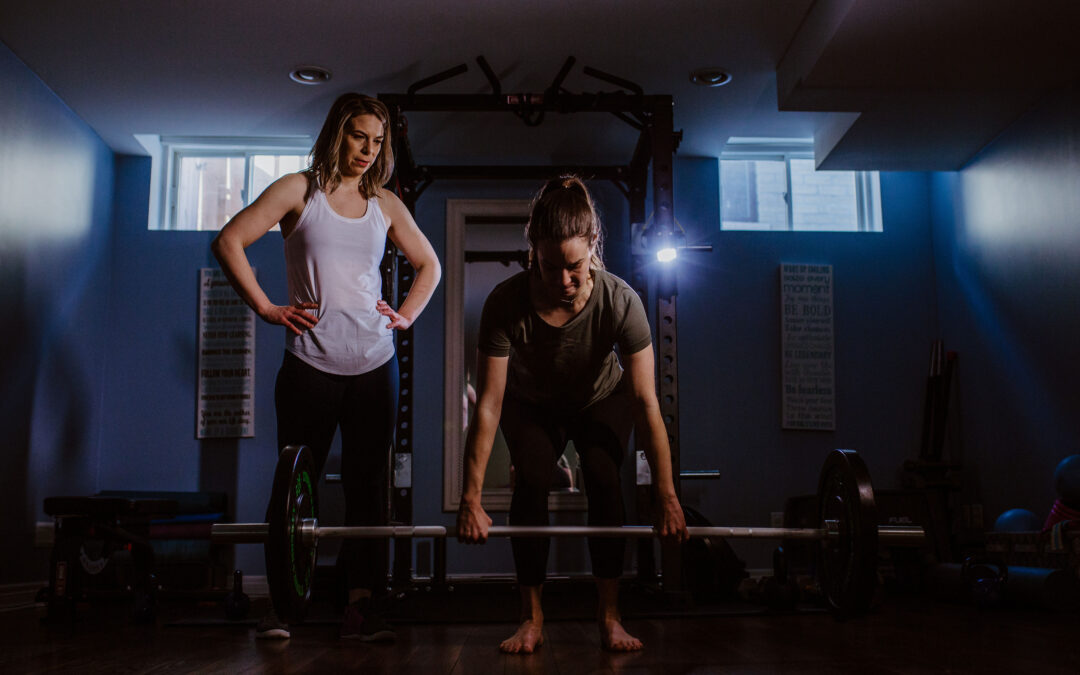How To Train Olympic Lifts With Pelvic Organ Prolapse
Olympic Lifts are one of the most dynamic lifts which can take considerable work from the pelvic floor.
And learning how to perform such a lift and your prolapse pops out to play, you know how discouraging this can be when it comes to training Hang Power Cleans and Snatches, and managing your prolapse symptoms.
But let’s say you love lifting heavy objects and olympic lifts, I have your back. But what we need to begin with when training HPCs, is a round of the basics.
First, You’ll Need To Learn Your ABC’s (Alignment, Breathing, & Coordination With Exercise or Movement):
Alignment
When standing in neutral, your diaphragm is seated directly over your pelvic floor. These two muscle groups along with your transverse abdominal and multifidus (deep muscles along the spine) work well together in unison.
When your ribs are thrusted upward or your pelvis is posteriorly tilted, this causes your diaphragm and pelvic floor to move out of alignment which also makes managing the intra-abdominal pressure difficult.
To stand in neutral, your ribs need to be directly in line with your hips.
Now, with this in mind, lifts like the hang power clean (HPC) and snatch require hip extension when making contact between the bar and the hips. This takes the spine and hips out of alignment for a few seconds.
This is why you’ll likely need to break down the HPC and Snatch into separate movements. Here’ you will master the control you need to manage your intra-abdominal pressure, in addition to the lift mechanics itself.
Breathing
Breathing is one strategy used to manage intra-abdominal pressure. What tends to happen is that too much air gets trapped in the belly, causing downward pressure on your pelvic floor.
In addition, when you use your breath, the diaphragm initiates pelvic floor movement. This encourages your pelvic floor to open and relax.
Breathing Strategies To Keep You Symptom-Free
Learn To Properly Kegel
Disclaimer. Your PTPT may not recommend kegels if your pelvic floor is overactive. That’s ok. You can learn to relax your pelvic floor to create movement to be able to perform a kegel. This is the time to down train your lifts by breaking them down into individual movements as well as reducing load.
Once you’re able to contract and relax your pelvic floor muscles, you can then add in heavier loads and use your kegel to assist in the lift.
To better understand how to do kegels properly, you’ll need to understand how your pelvic floor works. Check out WTF Is A Pelvic Floor, now to learn how these muscles work and function
A kegel is a muscle contraction in the vagina. You can hold it isometrically and let it relax. You need it to do both efficiently in your training (with and without) your pelvic health symptoms.
There is some confusion surrounding how to properly kegel. Women are taught to contract their pelvic floor without knowing how to relax them. This is where the pelvic floor becomes overactive and this may be why you’re experiencing peeing or feeling like something is falling out when performing these lifts.
Additionally, women will bear down (pushing down on the pelvic floor muscles, instead of lifting it up and in), thinking they are doing a kegel.
How To Kegel And Engage Your Core.
All you’re really doing here is a diaphragmatic breath with a kegel.
I like to teach this laying on your back, but you can do this seated, side-lying, sitting, and standing as well.
- Lay on your back in a glute bridge position. Make sure your alignment is neutral.
- Imagine yourself pulling your hip bones into your belly button.
- Inhale through your nose, drawing your breath up into and expanding through your rib cage.
- Exhale like you’re blowing through a straw while gently contracting your pelvic floor (only 20%-30%).
If you are unsure if you’re doing the kegel correctly, place 2 fingers on your perineum (the muscle tissue between your vagina and anus). On the inhale, you should feel your perineum come down. On the exhale, you should feel it rise up.
How To Coordinate Your Kegel With The Oly Lift
Whether you’re setting yourself for a lift or jump, you can time your breathing and kegel.
Discover my top 10 secrets to managing your pelvic health by downloading my free 10 Fitness Tips For Lady Parts: A step by step checklist to get you back into lifting heavy, running marathons and loving your body by tapping here.
If you feel bulging or experience any urinary incontinence, make sure you’re ribs are stacked over your hips and check your breathing. If you still have symptoms, reduce the load, and try again. You may need to run through this more than once.
Here’s How To Get Set Up
- Standing in your starting position, make sure your ribs are in line with your hips.
- A split second before you exert, exhale and kegel to brace your core (blow before you go as Julie Wiebe, PT cues it)
- Take note of tension to task and spread the load below.
- If you’re using a light load, breathing through the entire range of motion seems to work best for most people.
- If you’re using a heavy load, you may find a modified Valsalva helpful (a small exhale before the breath hold is one way)
Tension To Task And Spread The Load And Spread The Load.
These are important strategies I learned from Antony Lo, PT in his Female Athlete course. I myself used this strategy in my own 1RM training and had a 25 pound increase in my deadlift, going from 190 1RM to 215 1RM in less than 2 months. Without a single symptom.
Tension to task is applying the right amount of tension to complete the desired outcome. This is where you can find where you’re able to work without symptoms. You may also see an improvement with your lift when you apply the appropriate tension to the task at hand.
Keep in mind your tension to task will differ from lifting at 20% of your 1RM than it will at 100%, which means you don’t need the same tension picking up a hairbrush as you would lifting a car.
The same goes for your kegel. You don’t need to go full force for light to moderate load. Going from moderate to heavy or max lift, you will need quite more recruitment from your pelvic floor. You’re looking at just as much activation as the rest of the muscle working in that particular lift.
For example, if you’re lifting at 70%, you will need to recruit 70% of your pelvic floor. Lifting at 100%, you’ll need all of your pelvic floor strength.
This is why it’s important to build on your pelvic floor strength when training your 1RM. If your pelvic floor can’t match the needs of the lift, you may find yourself with symptoms.
Spread the load is in the same ballpark as tension to task. The goal is to distribute the load or pressure throughout the body, not just one area. This is helpful in learning not to bear down on the pelvic floor or abdominal wall, keeping the brunt of the pressure off your pelvic floor.
What This Means Going Forward
When you’re training like the Hang Power Clean, it’s best to train your pelvic floor and coordinating your ABC’s in a progressive manner. Sounds so sexy, I know.
But to learn how to pull this all together in one movement, it’ll work much better for you in the long run.
So if you’re just starting out in your pelvic floor muscle training, the first step is to master your ABC’s with a small movement like a glute bridge.
From there, you’ll need to train progressions with the ABC’s:
- Squats (bodyweight, goblet, front)
- Deadlifts (standard and snatch grip, segmented or pause)
- Mobility (hip, ankle, shoulder)
To see this all come together for the Snatch, watch the video below
To see this all come together for the HPC, watch the video below
Olympic lifts are one of the most challenging lifts to train when it comes to managing your pelvic organ prolapse because there are so many working parts to coordinate into one movement.
But it’s totally doable!
You’ll need to give this time. Even the most experienced lifters struggle to learn coordination. But once you’ve mastered what works, this will become automatic.
Stay patient and persevere my friend.
My 1:1 online coaching program for women with prolapse who want to lift heavy, get sweaty, feel brave in their bodies again, will take you from glute bridge to oly lifting in no time. If you’re ready to overcome your fears and take control for once and for all, tap here to see if working with me is a good fit.
Ciao my beautiful friend,
Terrell
Ready to maximize your postpartum fitness performance? Get my favourite strategies in Your Handy Lady Parts Handbook” 5 Considerations All Women Need For Fitness And Their Vagina. You will learn to minimize pelvic floor dysfunctions and improve your overall power you can use in both pregnancy and postpartum.


